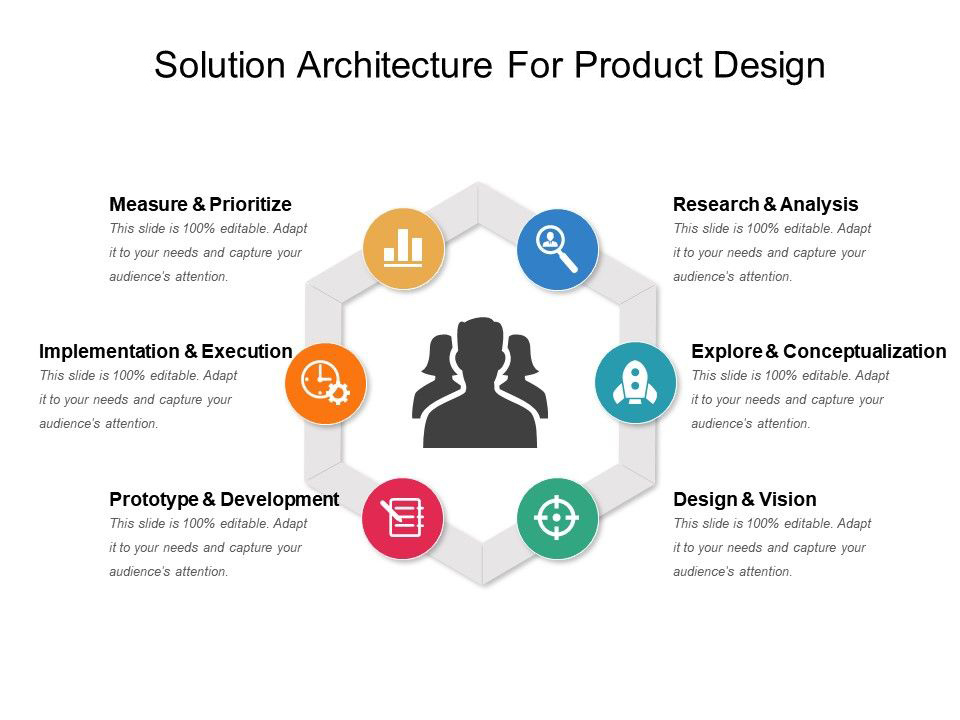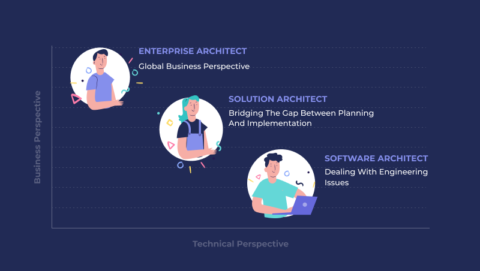Table of Contents
A Solution Architect is a professional who designs and manages the implementation of a specific solution or set of solutions within an organization. These solutions typically involve software or technology systems and are designed to solve specific problems or to improve specific processes within the company.
Solution Architects require a combination of technical expertise, business acumen, and excellent communication skills. They need to understand not only the technology and software they are working with but also the business context and the needs of the end users.
This article will provide solutions architect job description, how their role is different from other similar positions, and what kind of projects require input from these specialists.
What is Solution Architecture?
Simply put, solution architecture is a high-level description of a software product in the context of the problems it solves. In other words, solution architecture shows how a system and its specific features help a company reach its determined business goals.
Solution architecture is usually implemented as a part of enterprise architecture. The latter determines what business structure, processes, and operations allow a company to meet its strategic objectives. Alternatively, we may say that enterprise architecture defines how a company’s business strategy can be executed most efficiently. At the same time, solution architecture is responsible for the technological support of such execution.
Solution Architect Job Description
One of the most sought-after roles in software development companies is as a solution architect. What is a solutions architect? The solution architect works with the development team to create and integrate information and computing systems that meet specific needs. In other words, architect duties are connected with integrating software and hardware.

To ensure that the future solution is built as efficiently as possible, architects study the current system architecture and work with the commercial and technical staff.
The solution architect works directly on the project while the business analyst develops the requirements. They accompany the project right up to its completion. These specialists are responsible for the project vision that underlies the solution and translates that vision into reality.
Solutions architect knows programming, integrating, and testing software systems and related devices. They also decide on the appropriate technology to solve the problem.
Solution Architects focus on:
- how technologies can be used to solve this business problem;
- what framework, platform, or technical stack can be used to create a solution;
- how the application will look, what modules there will be, and how they will interact with each other;
- how the digital solution will scale in the future and how it will be supported;
- figuring out the risk in third party frameworks/platforms;
- find a solution to a business problem.
The solution architect must be able to describe the solution in a language understandable to all. No one had a question about what to do and how to achieve it.
Technical background and experience
As we said earlier, a solution architect must be able to form understandable requirements for all languages. For this, he needs experience from various fields, including technical. Experience should include knowledge such as:
- IT architecture, infrastructure, and cloud development
- DevOps
- Business analysis
- Engineering and software architecture design
- Project and product management
Excellent communication skills
Business owners and programmers usually speak different languages. Business owners often think about effectiveness, productivity, cutting costs, optimization, etc, while software engineers worry more about specific engineering challenges. In this context, a solution architect acts as a translator.
As a rule, this person has industry-specific expertise, so he or she understands what stakeholders want and why they want it. A solution architect role also presupposes strong technical skills that help him or her communicate a product vision to a development team.
Analytic skills
In addition to the project’s technical specifics, the architect must understand the business processes inside and outside the company and how it builds its corporate strategy and goals faces. As a result, we can say that a solution architect’s work consists of analytical work, not just technical work.
Project and resource management skills
The solution architect is not involved in project management. Still, he/she is focused on the highest quality result and that everything is completed on time. Therefore, they have to decide which decisions are beneficial and which are useless in a particular situation.
What does a solution architect do?
In general, solution architect roles and responsibilities include designing a solution architecture and implementing it in practice. They have a clear vision of a product and understand how this product should benefit a business. A solution architect also translates this vision to a coding team to build a highly tailored product to the enterprise’s needs and requirements.
It’s also worth mentioning that the role of a solution architect is not limited just to ideation. This person takes part in all stages of the product development process. To make it clearer, let’s look at the tasks solution architect job description should include.

Ideation
At the first stage of a project, a solution architect gathers the requirements for a software solution from stakeholders. Specifically, it communicates an idea of a product with business owners, top executives, and possibly customers to understand their pain points and requirements and define the future system’s right vision.

Implementation
The implementation stage covers the entire process of software development, including writing specifications and quality assurance. At first, a software architect works with the tech team to elaborate on all possible options of how the idea can be made a reality.
After that, they cooperate with a business analyst to help the latter properly translate stakeholders’ requirements into functional and non-functional requirements for a product.
Finally, a solution architect participates in making the most crucial technical decision that may impact the project’s ultimate results (for example, technology stack and integration with third-party systems).

Maintenance
A solution architect is also responsible for the continuous maintenance of a system developed. This person makes sure that there is a secure and stable IT environment for a software solution to work properly. Solution architects also ensure that such a solution will remain relevant in terms of the business value it should deliver.
In addition, the solution architect is responsible for ensuring that all requirements are met during development. He must examine the limitations of the project in order to optimize possible alternatives and reduce risks. In general, the solution architect is the link between the technical team and the project manager. It ensures the speed and accuracy of information transfer, as well as controls key development processes.
Back-end team lead, Max Galaktionov
Main processes covered by solution architecture
A well-planned solution architecture helps the team working on a project to meet deadlines, act on the budget, and create a solution according to previously agreed customer requirements. Let’s take a look at what specific processes the solution architect works with.
#1 Correspondence of solutions to the corporate environment:
If a solution is created to optimize internal processes, it is essential to develop a solution that will be easily integrated into the corporate structure. In such a situation, the solution architect must understand the company’s business processes in the solutions that are already used in the company. By understanding these processes, they will design a specific solution that is most suitable for the environment.
#2 Meeting the requirements of all stakeholders:
During the development process, there are usually several stakeholders who are both technical and non-technical. The solution architect should consider all software development requirements and provide updates about the development process, expenses, etc.
#3 Considering project constraints:
Each project has its limitations. This concept includes:
- technology
- risks
- scope
- cost
- quality
- time
- resources
For example, if we talk about integration with existing solutions, then a new project must be created using particular technologies to comply with the corporate system.
The solution architect must understand all of these constraints and consider the technical and business factors that ultimately need to align with the project’s goals.
#4 Selecting the project technology stack
This is one crucial point, as there are many different practices related to platforms, programming languages, and tools. The architect needs to determine which of the technologies will be most suitable for a particular project. This is a daunting task that requires experience with different technologies and highly relevant assessments.
#5 Compliance with non-functional requirements
Any project must meet the functional requirements and some non-functional requirements related to the characteristics of the system. The project’s complexity determines these requirements, but the most common are safety, performance, usability, and more. The solution architect’s role is to analyze all non-functional requirements and ensure that further product development will meet them. Read more about functional and non-functional requirements here.
Solution architect vs. Enterprise & Software architects
A solution architect is sometimes confused with enterprise architect and software architect. This is because their positions sound similar and the responsibilities overlap partially. Yet, each role is essential for a project’s success and cannot be substituted by another position. Let’s look at their differences more precisely.

Enterprise Architect vs. Solution Architect
We already discussed the correlation between the terms “enterprise architecture” and “solution architecture.” So you might have already guessed that the main difference between the role of an enterprise architect and the role of a solution architect lies in the scale of the view.
The former sees the entire enterprise ecosystem from a bird’s-eye view. This person also resolves the global challenges a business faces. He or she is mainly responsible for building a proper infrastructure to support a company’s business strategy.
The role of solution architects is much more practical. Basically, they take separate requirements to the global company’s infrastructure and turn these requirements into real solutions. In other words, solution architects create a bridge between planning at the enterprise level and developing specific software products that will help a company make these plans a reality.
Solution architect and Solution designer
Solution architecture is concerned with defining and designing the building blocks for a program and a very high level.
It is about understanding the current state, its impact on the overall architecture, and defining new blocks and their interfaces.
Solution design consists of a block design.
The initial high-level design will need to be monitored to confirm that it is consistent and compared with the solution’s overall design. Then the top-level design will need to be detailed.
Importance of Solutions Architect In a Company
If you do not need to integrate new software and modules regularly, you can use the solution system’s consulting service. If you only have one project that will not take very long to work on, you also do not need a solution architect.
If SA is involved in the development, you can be completely confident that the new software product will solve key business problems. This means that at the end of development, the company receives not just a working application, but a product that will lead to scaling.
When a company needs solution architecture consulting
Using examples, we will consider in more detail when it is worth seeking advice on power sources:
- You have doubts about the optimal solution for your company’s ecosystem. You need to establish a link between your existing enterprise architecture and a specific project. It is the architects who can guarantee that a particular project will meet your company’s standards.
- You are planning a digital transformation of your business. This process implies that the company is reviewing the value of the product or how they provide their product. In such a situation, a connection between technologies and business processes must be established, for which the solution architect is responsible.
- To mitigate the risks you might face on projects, you need a solution architect. It will help prevent the emergence of technological risks as, for example, the underlying technologies are not well suited to implementing a particular digital solution.
- There are non-technical stakeholders and engineers among the stakeholders, and you need them to understand. The architect of the solution can fulfill the function of the bridge by such parties. Working with the project management team, solution architects cover the risks of product non-compliance with stakeholder requirements and ensure that the solution meets its intended purpose.
- You have several teams working on your project, and for everything to work harmoniously for a high-quality technical result, you need a solution architect.
What projects require a solution architect
Of course, you don’t need to design and implement a solution architecture on all software development projects. For instance, if you want to create a simple one-page website, a coding team and a project manager will be able to do this without additional guidance from a solution architect’s side.
But to sort things out, let’s take a look at the types of projects that usually require the involvement of these specialists:
- A high level of complexity: if a system you are to develop will have advanced functionality, you need high-level management of the development process.
- Digital transformation: if your enterprise is undergoing a digital transformation, all new solutions must align with the global digital strategy.
- Many risks are involved: if you know that there are many constraints and uncertainties related to a project, consider engaging a solution architect to avoid failure.
Putting it all together
Even the most sophisticated software product is worth investing in only if it can bring real business value. A software architect is a person who ensures that you spend money on tech solutions wisely instead of taking a shot in the dark. Specifically, they are responsible for bridging the gap between a company’s business strategy and the technical solutions it purchases or builds.
What does a software architect do?
They provide technical leadership and make decisions regarding the most crucial elements of a system being created. The elements that would be hard to change after implementing and elements that may be related to failure risks. Also, the architect may sometimes propose technical standards, including coding standards, tools, or platforms. Software architects may also be engaged in the design of the architecture of the hardware environment.




